Spiel '14
Pevans reports from Essen
This is my initial report from the 2014 Spiel games fair in Essen, Germany. It concentrates on the games I played at the show. I will expand this with my notes on other publishers over the next few weeks, aiming to cover all the new games.
It is written as a narrative, to be read through from the introduction, but you can also use the links below for the list of exhibitors, list of games and sections of the report.
It is also available as a PDF document: Spiel '14 report (3.7 Mb). (You will need Adobe Reader to view this document – use the link to download it if necessary.)
List of exhibitors
| Name |
|---|
| Abacusspiele |
| Argentum |
| Asylum Games |
| Bezier Games |
| Board & Dice |
| G3 |
| Helvetia Games |
| Name |
|---|
| Irongames |
| Lifestyle Boardgames |
| Mayfair Games |
| Quined |
| Treefrog Games |
| Wattsalpoag |
List of games
| Title | Publisher |
My rating* |
|---|---|---|
| 15 Dias – The Spanish Golden Age | Asylum Games | 6/10* |
| Artificium | Lifestyle Boardgames | 7/10* |
| Costa Ruana | Lifestyle Boardgames | 6/10* |
| Dice Brewing | Board & Dice | 4/10* |
| El Gaucho | Argentum | 9/10 |
| Golden Ages, The | Quined Games | 9/10 |
| Imperialism: Road to Domination | G3 | 7/10* |
| Limes | Abacusspiele | 7/10* |
| Onward to Venus | Treefrog Games | 8/10 |
| Panthalos | Irongames | 8/10 |
| Royals | Abacusspiele | 8/10 |
| Switching Tracks | Wattsalpoag | 9/10* |
| Unita | Helvetia Games | 4/10* |
| * Provisional rating on my highly subjective scale | ||
Spiel '14 – my report
I always associate the Spiel games fair with Autumn. I expect to crunch through piles of dead leaves as I stroll down the Essen streets, wrapped in a warm jacket, hat and gloves. This year the weather was damp to start with and then bright and sunny - and definitely warm the whole time. This made tramping round the halls hot work, even in shirtsleeves, and I needed the water I was carrying (the odd lunchtime beer was also consumed).
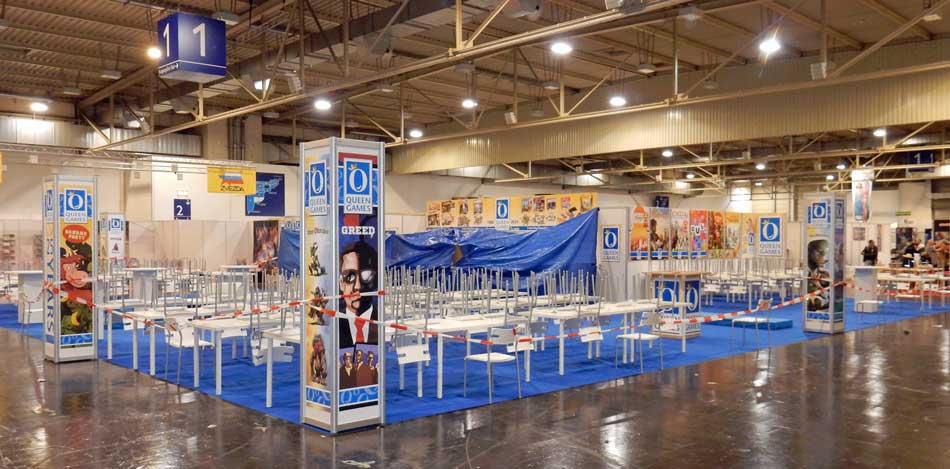
The night before: Queen Games on Wednesday evening, awaiting Thursday’s crowds
Talking to Spiel organiser Dominique Metzler on Friday morning, she was concerned that the warm sunny weather and a continuing strike by train drivers would mean fewer people visiting the show over the weekend. She needn't have worried, as the final figures show that a record 158,000 visitors came through the doors over the four days (and that is visitors, not visits, as a four-day ticket counts as one visitor). And they opened the doors early because of the crush outside!
Those who've been will know that Spiel is a showcase for new games, hundreds of them, as publishers promote their latest for this Christmas (games are a very seasonal business). The official statistics give 832 exhibitors from 41 countries with 850 new releases occupying 10,000 square metres more than last year. The emphasis is on board games, but there's a significant section of role-playing games (most obviously all the live action costumes, weapons and equipment) along with trading/collectible card games, wargames and everything else. There is also a comics convention, Comic Action, run alongside Spiel.
However, I'm there for the board games, particularly those that are launched at Spiel. This first iteration of my report concentrates on the games I played at the show (or in the evenings afterwards) - what makes Spiel different is that it emphasises playing the games, not just buying them. As I play more of the games - and time allows - I will add more. Note that when I refer to game being like another, I am not suggesting it's a copy. This is just a shorthand way of explaining a game by reference to another.
Hall 3
Where to start? Well, let's begin at the impressive west entrance to the Messe (exhibition centre), just above the U-bahn station. Ignoring the press centre on my left, the main doors take me into hall 3, where the big Asmodee stand bars progress straight forward. It's either turn left or turn right - trying to barge through the tables, chairs and gamers that fill the stand is a no-no. These days Asmodee's main business is distribution, so the stand is packed with games from the (mainly French) publishers they distribute.
My first port of call, however, is a few aisles into the hall. Abacusspiele is celebrating 25 years in the business. Vintage gamers, like me, know Abacus as the publisher of the original Airlines, back in 1990, and some fine games since, including Mamma Mia!, Hansa, Coloretto and bonkers dexterity games Husarengolf and Piratenbillard. The company won last year's Spiel des Jahres (Game of the Year) as the publisher of Hanabi.
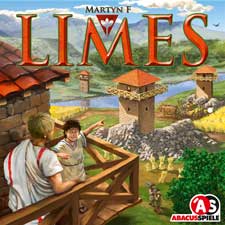 This year's new games include Limes, from French designer Martyn F, and Royals, from Aussie Peter Hawes. Limes is a two-player tile-laying game, a development of Martyn's Cities from 2008. The obvious comparison is with Carcassonne, as the tiles show different terrain and players score points for pawns placed on tiles according to the type of
terrain. However, the game also has a similarity to Take it Easy! as the second player must play the same tile as the first player drew randomly. Players are also restricted in the grid they must play their tiles into - 4 x 4 is the basic set-up and the game gets more challenging with other formats.
This year's new games include Limes, from French designer Martyn F, and Royals, from Aussie Peter Hawes. Limes is a two-player tile-laying game, a development of Martyn's Cities from 2008. The obvious comparison is with Carcassonne, as the tiles show different terrain and players score points for pawns placed on tiles according to the type of
terrain. However, the game also has a similarity to Take it Easy! as the second player must play the same tile as the first player drew randomly. Players are also restricted in the grid they must play their tiles into - 4 x 4 is the basic set-up and the game gets more challenging with other formats.
The square tiles are divided into four smaller squares and show several different types of terrain, though multiple squares can be the same. After playing a tile, players can place a pawn (meeple) on one small square. Thus pawns on watchtowers (the Limes of the title) score for the forests they look out over. While pawns on fields score for the size of the field.
Instead of placing a pawn players can move one that's already on a tile. This is a neat way of allowing players to adjust their scoring opportunities as their layout changes. Of course, the challenge is making better use of the same tiles and pawns than your opponent. Limes is a neat, clever little game that plays quickly to a conclusion. Two-player games are not my thing, though, so it only gets 7/10 on my highly subjective scale.
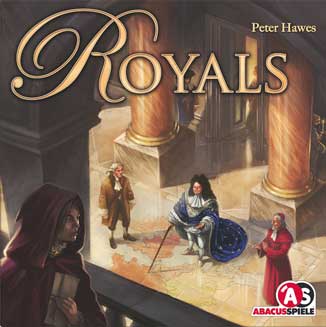 Royals is much more my cup of tea. Played over a map of western Europe, players compete for nobles of various ranks across four 17th century kingdoms (a bit of historical licence has been taken here). This is done by playing sets of cards for the appropriate 'kingdom'. If players aren't playing cards, they're picking them up, so key to the game is just when you switch from collecting
to playing - when you
hit the hand size limit is one answer.
Royals is much more my cup of tea. Played over a map of western Europe, players compete for nobles of various ranks across four 17th century kingdoms (a bit of historical licence has been taken here). This is done by playing sets of cards for the appropriate 'kingdom'. If players aren't playing cards, they're picking them up, so key to the game is just when you switch from collecting
to playing - when you
hit the hand size limit is one answer.
Players score points for collecting all the nobles in a country, all the nobles of the same rank, a noble in every rank and so on. There are bonuses for being the first to do any of these, too. The game is also divided into three eras with additional scoring for what you hold at the end of each era.
Once you've got the hang of it, Royals plays quickly, especially when everybody's collecting cards. While you are limited by the cards you have, multiple cards can be used as a wild card, which provides some flexibility. I suspect the way to win is to collect what other people aren't going for, as well as making best use of your cards. On first acquaintance, I give Royals 8/10 on my highly subjective scale.
While I'm writing about Abacus, I'd like to offer a big thank you to the company's main man, the ever-affable Joe Nikisch. When I dropped by the Abacus stand late on the last day of Spiel, Joe pounced on me and insisted I sit down and play Limes with him. Now this is a bloke at the fag end of four gruelling days (more if he was working on the set-up) at Spiel (and I know, I've been there myself), the man who hires people to demonstrate the games he publishes. He knows I'm not going to buy anything but is very happy to chat, playing a game that he must be very familiar with. What's more, he then presents me with the game when we've finished! Thank you again, Joe, you are a gentleman and I look forward to many more years of games from Abacus.
A few aisles back and I find Argentum and the publisher's cheerful boss, Roman Mathar. Argentum is launching an alternative board (Britannia) for Hansa Teutonica, providing new challenges for players. However, their new game is El Gaucho, which, Roman tells me, is a more family-orientated game, but one that has been going down well with gamers. The amusing drawings of the gaucho and cows on the cover send the same message. Having played the game, all I can say is that Roman expects more from his family than I do from mine.
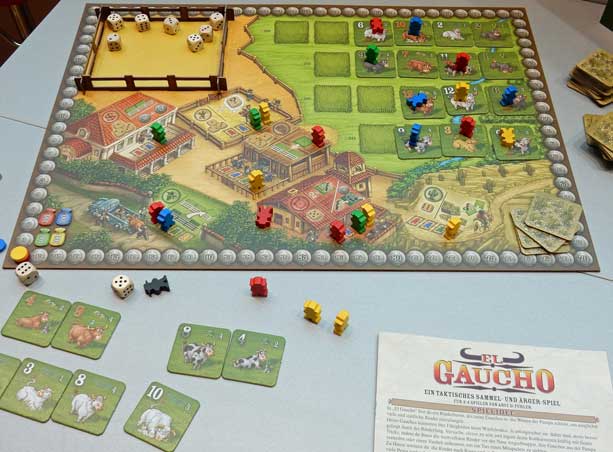
El Gaucho on display in the exhibition of new games. Note the useful corral for rolling the dice in.
As the name suggests, we are on the Argentinian pampas, rounding up cattle with our gaucho pawns. The tiles representing the cows go into separate herds (rows) according to breed/colour. Tiles are always added to the end of the row and must always go in numerical order. When a herd is big enough, it can be sold - and must be sold if you get a tile you can't add. The value of a herd depends on the number of tiles and the highest value tile in it.
Players gain tiles by using each round's dice rolls to 'buy' them from the several rows available. However, players only get their cows when the whole row has been bought. As well as taking cows, dice rolls can be used to put gauchos on the various buildings in the 'ranch'. Each of these gives a special action – inserting a cow on the middle of a herd, for example, or even taking one (rustling!) from someone else. However, you don't get the action until next turn. This clever two-stage effect lifts El Gaucho out of the ordinary and does indeed make it an interesting game for gamers. I give it a provisional 9/10 on my highly subjective scale.
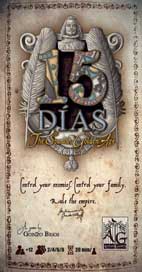 Towards the back of Hall 3 I found Spanish publishers Asylum. Their latest is an intriguing card game, 15 Días - the Spanish Golden Age. The game's theme is the intrigues at the court of the young King Phillip IV, in particular the two families vying to win the role of Prime Minister (and thus become the force behind the throne). Pete Card
and I were thoroughly confused by the explanation to begin with, but picked up enough to play a few turns. The additional rules for the two-player game seem to be the culprit.
Towards the back of Hall 3 I found Spanish publishers Asylum. Their latest is an intriguing card game, 15 Días - the Spanish Golden Age. The game's theme is the intrigues at the court of the young King Phillip IV, in particular the two families vying to win the role of Prime Minister (and thus become the force behind the throne). Pete Card
and I were thoroughly confused by the explanation to begin with, but picked up enough to play a few turns. The additional rules for the two-player game seem to be the culprit.
The unusual thing about this game is that there is a team element not just to the game but to every round. The cards, representing different nobles, have strengths in three areas/colours (church, social, court) plus two actions (Court, Admin). Each round the teams compete first, but must do so using the colour picked by the opposition. Then players get individual turns, using the third colour for their strength. As well as trying to win points, players are, of course, looking to improve their hand of cards - and degrade their opponents'.
15 Días is an intricate little game that clearly needs careful thought. Now that I've read the rules, I'm looking forward to playing it properly as it will be an interesting challenge. It does need an even number of players though. However, that initial introduction means it gets a provisional 6/10 on my highly subjective scale.
Right at the back of hall 3 was Dutch publisher Quined with two new games. Massilia looks interesting - it's been rescued from a Kickstarter project that went wrong - but the game I played is The Golden Ages. This is a civilisation development game and many of its elements will be familiar: leaders, wonders, buildings, wars and technology. However, these elements have been put together in a rather different way.
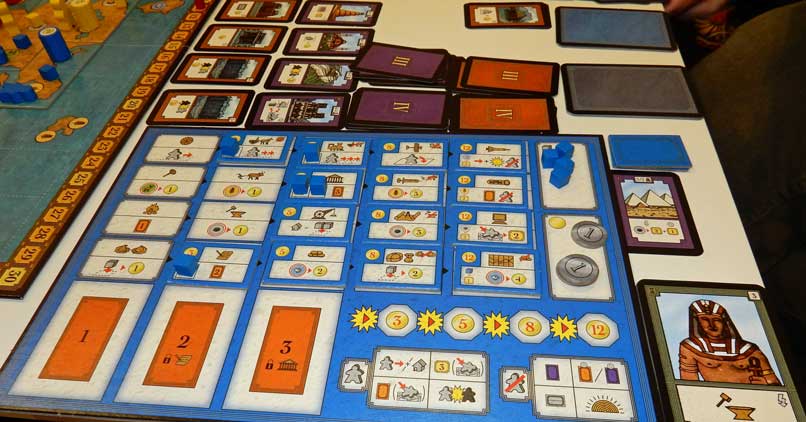
Early days in The Golden Ages, but look: I’ve got the pyramids! Just not much technology (tiles are still on my board) and no buildings (bottom left) yet.
To start with, players have three workers each. That's not to begin with, that's your lot! Using your workers wisely is thus a key part of the game. However, there are some actions that don't need workers and, once you've built them, some buildings and wonders give additional actions. Income comes from grabbing new territory, but there's a finite amount of this so you may well be fighting other players. In this game, though, you are limited in the number of times you can wage war and each time it's more expensive!
One neat touch is the familiar bits of land on the tiles players pick at random. Assemble them correctly and you have a map of the Earth. More or less. The Golden Ages is a clever and entertaining game that I thoroughly enjoyed and look forward to playing a lot more. It's my favourite of the games I played at Spiel and gets a provisional 9/10 on my highly subjective scale.
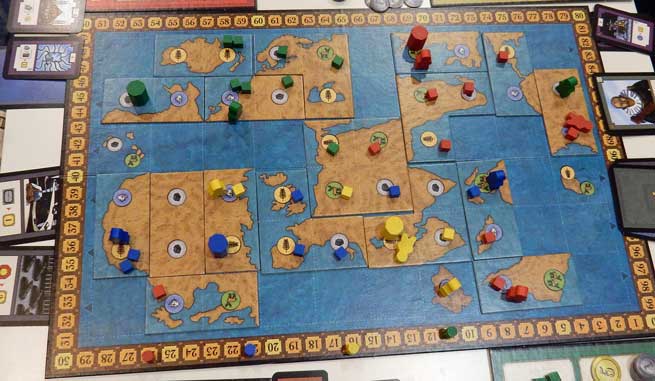
The final board from The Golden Ages. Wait: what’s Australia (top left) doing next to Scandinavia?
Hall 2
The door at the back of the hall take you into one end of the Galleria, the long narrow area of children's attractions (bouncy castles etc) that runs along between halls 4 and 2. Part of hall 4 was open this year with a few exhibitors tucked away here, but I'll move on to hall 2. This was dominated by the role-players with some magnificent selections of fantasy clothing and equipment - more latex weaponry than you could shake a stick at!
However, there were some board games to be found in hall 2, not least from Kris Gould and Wattsalpoag. Production delays meant that Kris's new game, Switching Tracks, was only present in prototype form, but at least I could play it. This is a pick-up-and-deliver game played across a board of the USA with railway lines connecting the major cities. Each city is coloured to represent the type of good (appropriately shaped wooden pieces) in demand. The pieces available are distributed at random according to the turn of a card. A neat touch is that 'demand' markers are placed if the good on the card is the same as the demand at the city and these increase the value of deliveries to that city.
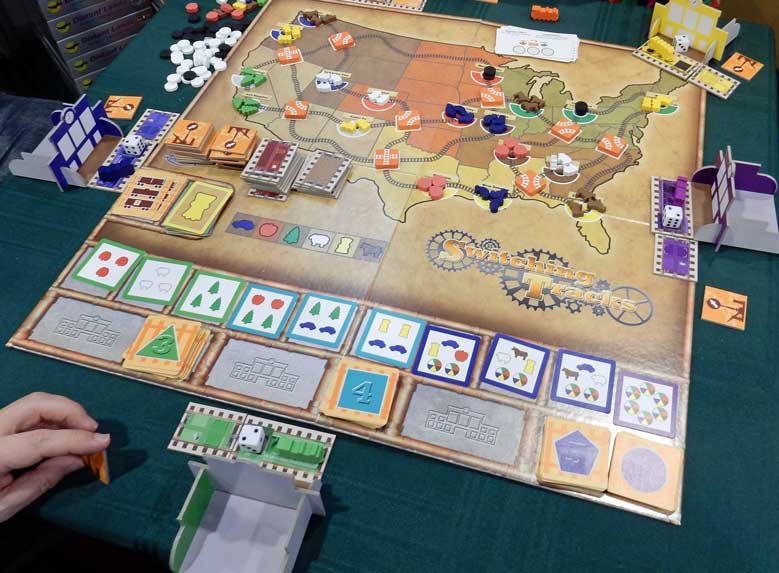
About to start Switching Tracks – note the switches are either + or )(
Goods are collected (if your train has space) and delivered simply by passing through the right city. Once delivered they can be used to fulfil contracts - which is the way to win the game - or to improve your train (so that it can move further or carry more goods, for example) or provide other bonuses. The key to the game is that anywhere railway lines cross there is a tile showing how these lines pass each other. Before moving your train you get to turn or flip a few of these, changing the network of railway lines to optimise your journey.
This may sound like a small thing, but it's what makes the game. The tricky bit then becomes negotiating the fixed parts of the network. And dealing with the changes the other players make. Switching Tracks won't be everybody's cup of tea as there's little interaction between players and analysis paralysis could be a problem. I liked it though and it gets a provisional 9/10 on my highly subjective scale. Kris hopes the game will be in the shops before Christmas and I'll be picking up a copy as soon as I can.
A dice game about beer sounds right up my street! The game is Dice Brewing from a Polish publisher I'd not come across before, Board & Dice, who were lurking in hall 2. It looked intriguing, so I was pleased when Richard Dewsbery produced a copy back at the hotel one evening. Players each have a set of dice whose colours represent different elements of the brew - hops, dark and light malt and so on. The aim is to use their dice to match one of the brews (cards) available, which show a combination of dice with minimum values. These cards are the main way of scoring points and the game ends when a certain number have been taken.

Playing Dice Brewing: note my storage area on the right and a black die and a seed producing things. Available brew cards are at the top and there are plenty of dice!
As you'd expect, it is not simply a case of rolling the dice and hoping (though that does seem to be an element of the game). Dice can also be used to produce seeds (chips) that can then be converted into more dice - the two stages of this process means it takes a bit of time. Players can save good die rolls in 'storage' between turns and change or re-roll dice by using the cards they've obtained. There's also the need to gain a bit of cash to buy special ingredients for particular brews or improve their brewery.
There's a lot going on in Dice Brewing and it has some neat mechanisms - like the production process. However, I found it frustrating as I didn't seem to have much control and was dependent on good die rolls. Other people stealing dice didn't help! In the end, I was just waiting for the game to finish. Based on this experience, it gets a provisional 4/10 on my highly subjective scale.
Hall 1
My circuit of the halls at the 2014 Spiel games fair brings me finally to Hall 1, which is a more interesting shape than the others (they're just rectangular hangars). First because it's a triangle with an irregular base - leading into the extensive foyer of the south entrance - and second because of the exhibitors here.
Tucked into one corner is one of my favourite publishers, Treefrog Games, now based in New Zealand where designer Martin Wallace has moved. However, the Mancunian "Froggies" were out in force to demonstrate Treefrog's latest. As a subscriber, I was disappointed that production problems meant I hadn't received my games, but I quite understand that, commercially, the business can't afford not to sell the games at Spiel. (I can report that my copies arrived before Christmas and are being played keenly!)
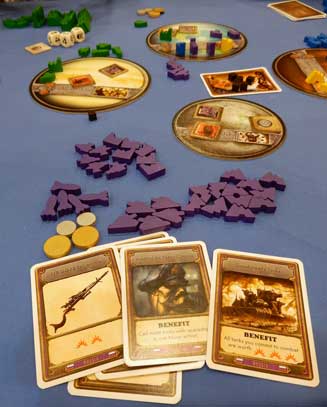
Cards and (Russian) pieces for Onward to Venus
The first of the two new games is the long-awaited Mythotopia. This is Martin's multiplayer, card-based, fantasy wargame, developed from his brilliant A Few Acres of Snow. It was the second game, Onward to Venus, that I got to play at Spiel. This is a licensed product, taking its inspiration from Greg Broadmore's Dr Grordbort's, which means nothing to me. However, I was immediately captivated by the retro, 1950s SF style: ray guns, rocket ships and bug-eyed monsters. Except that it's actually a late Victorian/Edwardian setting of imperial expansion across the solar system with no BEMs!
Rather than a board, the playing area is a series of cardboard discs that represent planets and moons in the solar system. Players use their spaceships, troops and tanks (nicely illustrated cardboard counters in the basic edition, great wooden pieces in the limited edition) to establish mines and factories on the various worlds. And, of course, take them away from each other. However, what players can do is constrained by the tiles placed on the worlds at the start of each round - and what units and cards they have (each can only be used once a round). The tiles may also provoke major events, such as native uprisings (each world is inhabited of course) or even an alien invasion from outside the solar system. Unless the players make sure they deal with the threat quickly.
Mines and factories provide income at the end of each round, money that can be used to buy more units. Players' relative income on each planet scores them points, according to the importance of the planet, at the end of the game and most points wins. As you'd expect with a Martin Wallace game, there are several neat mechanisms that provide tactical opportunities for players. However, there's also a hefty helping of luck, which I know will not be to everybody's taste. I think Onward to Venus is a cracking game, though and give it an initial 8/10 on my highly subjective scale.
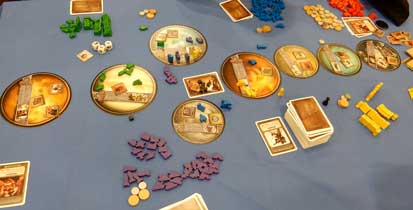
The full picture: Onward to Venus in play
 Moving out of the corner a bit, we come to the green banner proclaiming Bezier Games where we find games designer Ted Alspach. His new game is, of course, Castles of Mad King Ludwig, which I first played at the Gathering - see my report for details, but it gets 9/10 from me. Also on show was Subdivision, a thematic sequel to Ted's Suburbia designed by Lucas Hedgren, and Ted's latest
in the Ultimate Werewolf range.
Moving out of the corner a bit, we come to the green banner proclaiming Bezier Games where we find games designer Ted Alspach. His new game is, of course, Castles of Mad King Ludwig, which I first played at the Gathering - see my report for details, but it gets 9/10 from me. Also on show was Subdivision, a thematic sequel to Ted's Suburbia designed by Lucas Hedgren, and Ted's latest
in the Ultimate Werewolf range.
Lifestyle Boardgames is a Russian company that publishes Russian-language editions of many well-known games and their stand was just round the corner from Bezier. They have their own game designs, too, and Pete Card and I stopped by to try their latest. We were joined by Heli Barthen, one of our German gaming friends, to make four with Anna Maksimova from Lifestyle.
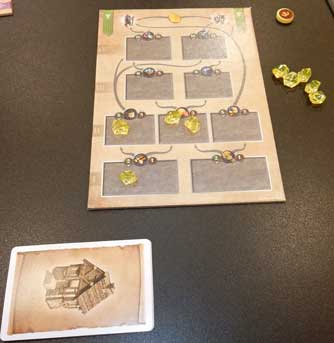
My board with resources and cash during Artificium
The first game we played was Artificium, a card game with an interesting development mechanism and a mediaeval fantasy setting. It's played over just four rounds, so efficiency is a necessity. The start of each round has a neat mechanism for tuning your hand of cards - at a cost. Then it is time to play cards. Action cards allow players to gain - or steal - cards and cash, while building cards upgrade players' goods and score points. Each player has their own board and uses the generic gem pieces to show what resources they hold (gems off the board are money). The board shows the purchase and selling prices of each good and the possible upgrade paths.
Key to the game is thus working out how best to use your cards, goods and cash to score points. The game's designer, Timofey Shargorodsky, was on hand to advise, which is always a help. Generally, the best points come from upgrading goods as far as possible - ideally achieving the peak of knight or wizard and scoring the maximum. Artificium is more tactical than strategic as cards are replenished each round, so there's little advantage in keeping them between rounds.
On first acquaintance, Artificium does not seem to be a particularly deep game. There's certainly a challenge in working out the optimum actions each round, but this is always constrained by the cards available. Of course, your best-laid plans are still subject to disruption by the other players! So, a decent, lightweight game with some interesting mechanisms. I give it a provisional 7/10 on my a highly subjective scale.
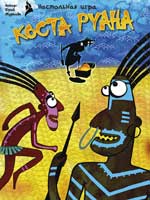 Lifestyle's second game is Costa Ruana, which is very different: it has meeples, a totem pole and wigwams to hide your treasure - the same gem pieces as Artificium. It also has some striking illustrations. This game is played across a number of islands (depending on the number of players) with players claiming a treasure if they have the most pawns on an island at the end of a round.
Lifestyle's second game is Costa Ruana, which is very different: it has meeples, a totem pole and wigwams to hide your treasure - the same gem pieces as Artificium. It also has some striking illustrations. This game is played across a number of islands (depending on the number of players) with players claiming a treasure if they have the most pawns on an island at the end of a round.
Pawns are moved and added according to the cards played each round. Players may put cards in front of themselves or other players and may play them face-up or face-down. It's immediately clear that there's some scope for bluffing here. What's more, cards come in four colours, but only two of these will be in effect each round - as chosen by the first player after all the cards have been played. This seems a neat mechanism but, on first acquaintance, the first player's scope for bluffing seemed limited.
The game is played over five rounds, after which the treasures hidden in players' wigwams are revealed and whoever has the most wins. Costa Ruana came across as a charming, lightweight game that will go down well with families. I give it a provisional 6/10 on first acquaintance.
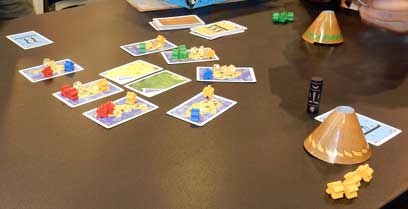
Playing Costa Ruana at Spiel
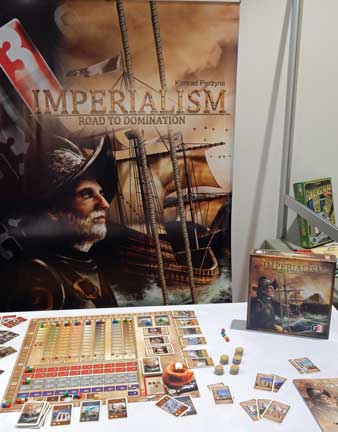
G3’s Imperialism on display
One aisle over from Lifestyle was Polish publisher G3 with Imperialism: Road to Domination, another clever civilisation development game. Pete and I had to have a go at this. It's a game that's clearly driven by the cards - the board is a collection of tracks for monitoring players' strengths and abilities. Even territory is cards, which players conquer as they expand their empire.
Players only get one action each round and can't take the same action twice in a row. This is shown by a cube on the appropriate action space on the board. Knowing which actions your opponents can't take is an interesting tactical advantage. Players can conquer territory, develop their industry/commerce, tax to raise money, intrigue against other players or declare war! Interestingly, it is possible to negotiate your way out of war - but you're generally going to have to give your attacker something.
The main aim is to score 'glory' points for your empires, which needs substantial development and/or colonisation, suggesting the game could be quite lengthy. However, the chain reactions caused by combinations of cards allow players to make rapid progress at times. The game end is triggered when one player achieves enough glory. Final scoring bonuses will add further points to the players' scores and whoever ends up with the most is the winner. There is, of course, an awful lot going on in this game with tactical opportunities galore and probably a lot of strategic options too. Definitely one I want to play again, I'll give Imperialism a provisional 7/10 on my highly subjective scale.
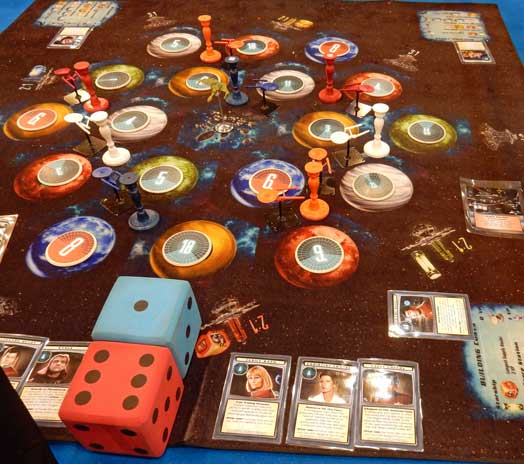 Just across from G3 was Mayfair Games with, among other things, a giant Star Trek Catan set. Pete and I were roped into playing and quickly discovered that the game is essentially Settlers of Catan. You may be collecting dilithium crystals rather than sheep and establishing space stations instead of settlements, but the mechanisms are identical.
The one wrinkle is the addition of characters cards - the crew of the original starship Enterprise. Each card has a special
ability that gives the owning player
a bonus. However, a card can only be used once or twice before it must be traded for a different one - a neat mechanism that stops anybody hogging a useful card. However, being all too familiar with Settlers, Pete and I made our excuses and moved on after a couple of rounds.
Just across from G3 was Mayfair Games with, among other things, a giant Star Trek Catan set. Pete and I were roped into playing and quickly discovered that the game is essentially Settlers of Catan. You may be collecting dilithium crystals rather than sheep and establishing space stations instead of settlements, but the mechanisms are identical.
The one wrinkle is the addition of characters cards - the crew of the original starship Enterprise. Each card has a special
ability that gives the owning player
a bonus. However, a card can only be used once or twice before it must be traded for a different one - a neat mechanism that stops anybody hogging a useful card. However, being all too familiar with Settlers, Pete and I made our excuses and moved on after a couple of rounds.
On the other side of Mayfair we found Bernd Eisenstein and Iron Games. Bernd's new game is Panthalos and I'd ordered a copy in advance. Thus it went back to the hotel with me and was played Thursday evening. My first impression was that it looked like Tribune with a board showing buildings where players place their worker pawns to take actions. However, while Tribune is set in Imperial Rome, Panthalos is in the Ancient Greek city of Corinth - and is threatened by Titans breaking out of the underworld.
What's more, in Panthalos players' workers are dice, with the visible face showing the worker's current strength. As you'd expect, workers can only be placed where they have sufficient strength to carry out the action of the building - which might be increasing the strength of a worker or gaining a new one. Players can also pick up goods, refine goods into more valuable ones (grapes turn into wine, for example) and sell goods to merchants (wagons) for immediate points or to traders (ships) for a few points now and maybe more later.
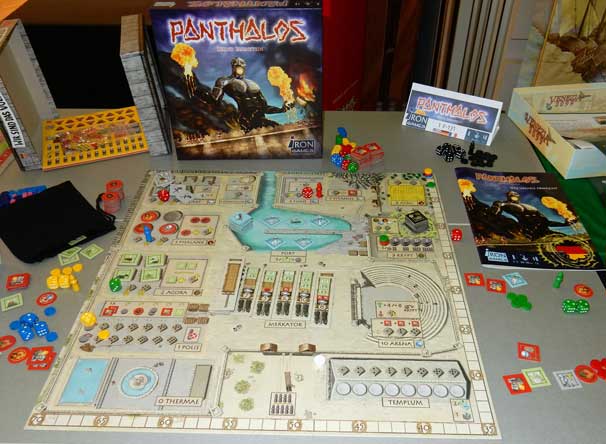
Panthalos on display in the new games exhibition
One significant action each round is for players to deploy their resources to defeat the current Titan. Fail to do so and you get a penalty; succeed and you score a few points. A neat touch is that, having done their jobs, workers retire to the baths and can't be used in the next round. Managing your workers is thus an important tactical element. The game is full of clever checks and balances like this and offers lots of tactical options. Panthalos has made several appearances on the games table since I returned from Spiel and will continue to do so. I give it a provisional 8/10 on my highly subjective scale.
Coming to the far end of hall 1, Pete and I took the opportunity of empty chairs to sit down at Helvetia Games and play their new game, Unita. This is nominally about warring factions in a fictional fantasy land (and definitely not Switzerland), but is actually a very abstract wargame. Each faction has one of the concentric tracks that lead from the edge to the centre of the board. Their military units are blocks of four dice, which players move along their track by playing cards. When two blocks end up adjacent to each other, there is a fight. The weaker of each adjacent pair of competing dice is reduced by a point and then each set is swapped to the other side of its block.
When they reach the centre of the board, blocks are removed and players score the final value of their dice. The game ends once a certain number of blocks have exited and the most points wins. There are clearly lots of tactical options here. Players start with the same set of values on their dice, but are free to organise their units as they see fit: a very strong unit will mean the others are weaker - or maybe there's just one very weak unit. Decisions, decisions.
Playing the game showed that it's definitely not straightforward. Because of the way the tracks spiral in, players' units will have to deal with all the other players at different times and can get absolutely crushed if they're caught in a corner. Unita is a clever game with some neat mechanisms, but it was far too abstract for me. It gets a provisional 4/10 on my highly subjective scale.
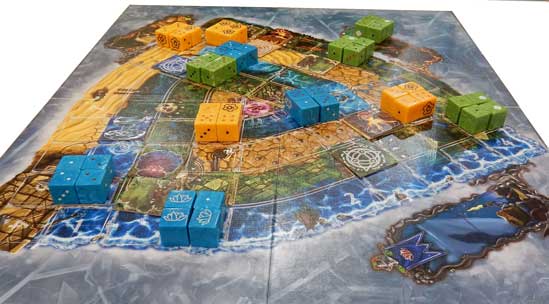
Our three-player game of Unita
This wraps up my initial report from Spiel '14, focusing on the games I actually played at the fair. Top of my list is Luigi Ferrini's The Golden Ages from Quined. El Gaucho (Arve Fühler, Argentum) is close behind, despite being a very different kind of game, and there's a fight for third place between Onward to Venus, Panthalos and Royals. There were plenty of excellent new games and I look forward to playing more of them. I will be adding to the online version of this as I do so, with the aim of getting as complete coverage as I can manage.
The 2015 event, Spiel '15, is scheduled a bit earlier than usual: 8th-11th October. The venue remains the Messe (exhibition halls) in Essen and the organisers, Friedhelm Merz Verlag, stay the same. I'm anticipating another four days with lots of exciting new games and will be keeping track of preparations on the website.
Photographs by Pevans, who played with Photoshop. Game artwork courtesy of the publishers, all trade marks acknowledged.
This report was first published (in two parts) in To Win Just Once issues 150 (December 2014) and 151 (January 2015).

